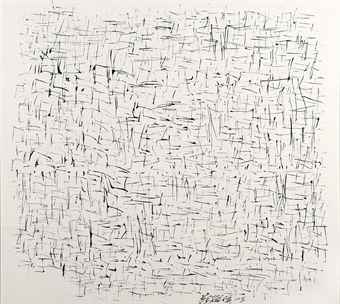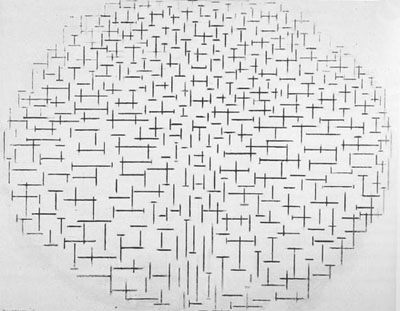
Chua Ek Kay
Lotus Pond: Reflection, 2005
ink on paper
90 x 95 cm.

Piet Mondrian
Composition 10 Pier and Ocean, 1915
oil on canvas
85 x 108 cm
你好! Today, I will talk about one of my sources of inspirations, which is Piet Mondrian. As you can see, Piet Mondrian painted different compositions of Pier and Ocean, and I was motivated to incorporate western influences into Chinese calligraphy paintings. I mustered my courage to push the boundaries and created works that were not understood and perhaps rejected by society.
When I was exposed to Piet Mondrian's works, Pier and Ocean attracted me a lot and so I got inspired to create a composition dominated with vertical and horizontal brushstrokes. The grid-like structure in Pier and Ocean is derived from an art movement called Cubism. As stated in the title of Mondrian's artwork, the painting solely depicts piers and the ocean in a highly stylized form that might not resemble anything in reality at first glance. However, upon closer inspection, one can see that the vertical strokes are the piers while the diagonals created by both the vertical and horizontal strokes are the waves, creating a sense of movement. Similarly in my artwork called Lotus Pond:Reflection, no distinguishable traits of a lotus are found. However, when one looks closely, he or she would realize that the brushstrokes vary in thickness. So, the thicker brushstrokes might be used to represent the lotus while the thinner and brushstrokes might be used to create the ripples of the pond.
Despite similar painting styles, there are differences in our works. In Pier and Ocean, Mondrian's composition is contained in an oval format, while in my artwork, i chose to unify the picture's elements into a square. Furthermore, my painting seems more chaotic than Mondrian's artwork. In Pier and Ocean, Mondrian chose to organised his lines in an organised, grid-like system while in my painting, I painted the lines rather messily, adopting the principles of abstract expressionism. So, although my painting seems chaotic, the brushstrokes are expressive which captured the essence of the artistic process of creating art with ink. The vital brushstrokes capture life and meaning on paper.
To conclude, although ink is a chines traditional painting medium, we all can use it and infuse western and chinese influences to create a whole new composition.




